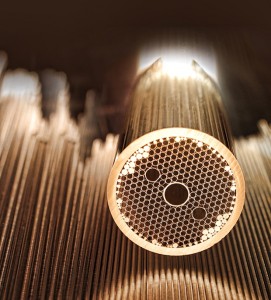
 DARPA’s COUGAR hollow core optical fibers transmit light at 99.7 percent its speed in air, according to the agency. Credit: DARPA.
DARPA’s COUGAR hollow core optical fibers transmit light at 99.7 percent its speed in air, according to the agency. Credit: DARPA.
Optical fibers typically consist of a transparent core surrounded by a transparent cladding material. The outer material has a lower index of refraction than the core material, thus trapping light in the core by internal reflection and causing the fiber to act as a waveguide.
More recently, researchers have developed hollow-core glass fibers that facilitate light transmission through the fiber—it’s easier for light to travel through air than through glass. The hollow-core fibers allow higher power transmission and reduce the need for repeaters to keep the light moving through the fiber.
Now researchers funded by the Defense Advanced Research Projects Agency and led by scientists at Honeywell Inc. have succeeded in creating hollow-core optical fibers they say allow light to travel through the fiber at approximately 99.7% the speed of light in air, a 30% improvement over silica glass optic fibers.
According to a DARPA news release, the novel fiber design uses a hollow core and forces the light to travel through channels of air instead of the glass around it. Each fiber is physically separated, allowing for higher bandwidth, and any polarization is kept intact—a key capability that enables advanced sensing, secure communications, and other applications. The hollow-core fiber can also be bent and coiled and still maintain transmission speeds 30 percent faster than conventional fiber, the release says.
One sure application for the fiber DARPA’s ongoing Compact Ultra-Stable Gyro for Absolute Reference (COUGAR) program, which would enable precision positioning when GPS capability is unavailable or denied.
“Previous hollow-core fibers have shown these high propagation speeds, but they weren’t able to do so in combination with the properties that make it useful for military applications,” DARPA program manager Josh Conway says in the release. “The real breakthrough with COUGAR fiber is that it can achieve a single spatial mode, maintain polarization, and provide low loss, all while keeping more than 99 percent of the optical beam in the air.
“While we are still working on integrating this new technology into a gyroscope, the fiber itself is revolutionary,” Conway adds. “This type of technology may also lend itself to other types of high-power sensors and additional applications where intense optical beams are required. Hollow-core fiber is also naturally radiation hardened, so it may open up fiber applications to space systems.”
